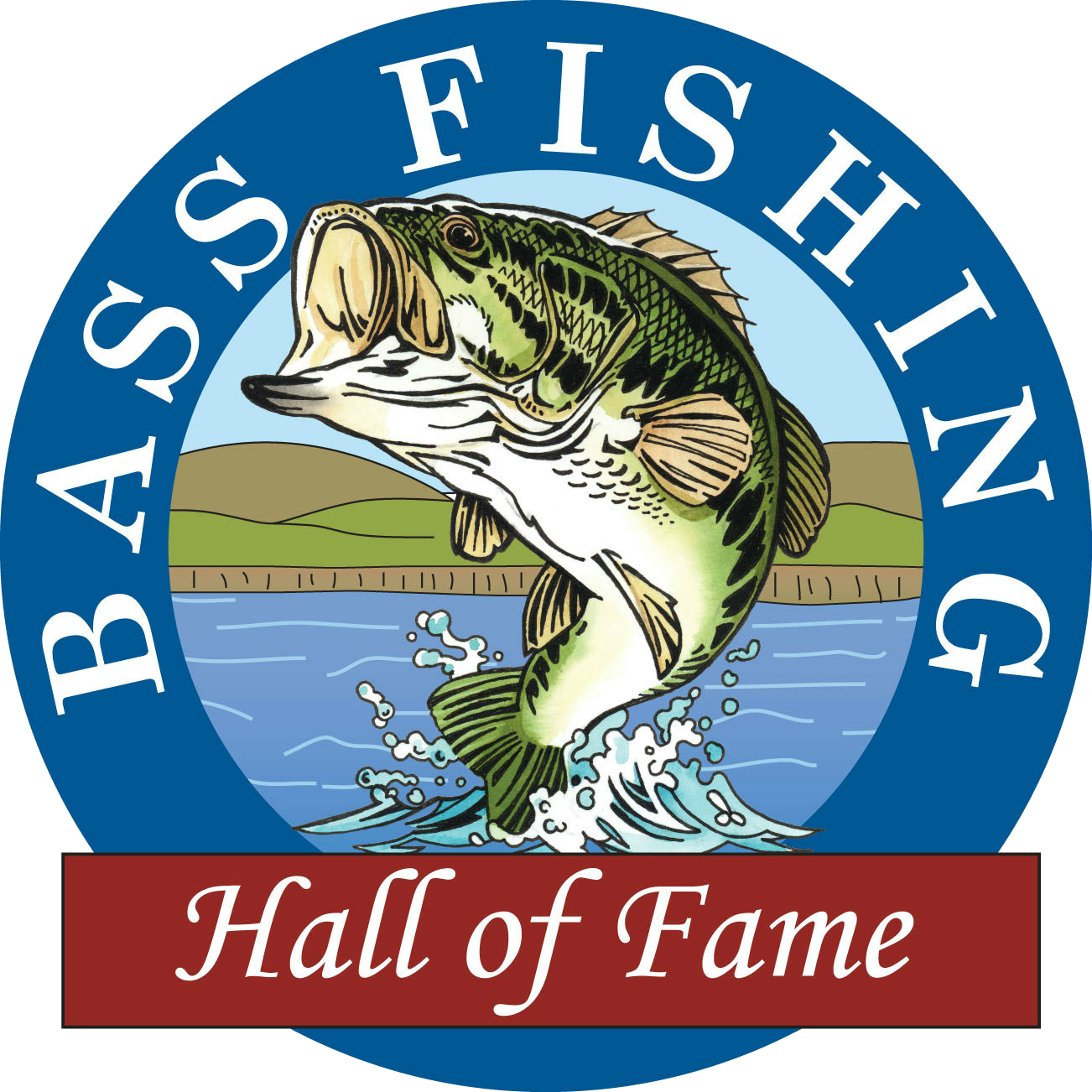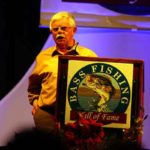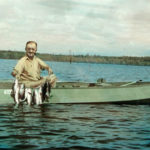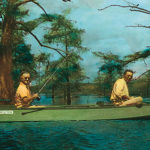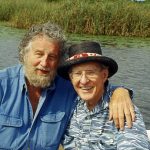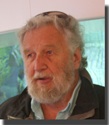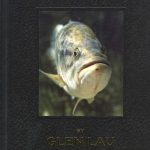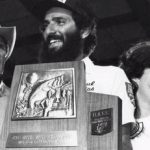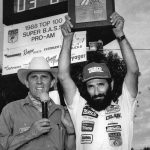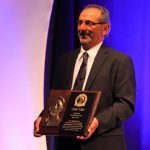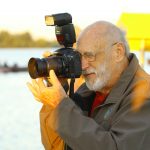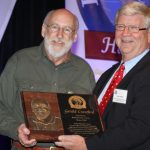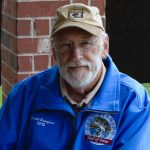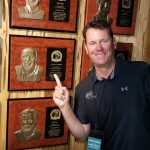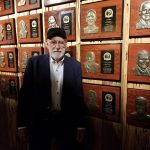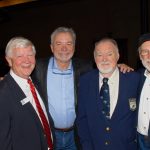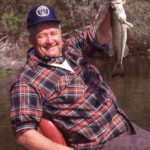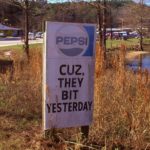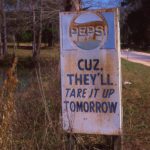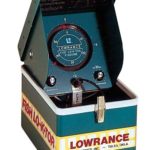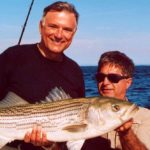Holmes Thurmond
Holmes Thurmond — Through the 1940s, fishing boats for freshwater were either flatbottom barges that were slow and hard to guide with a sculling paddle, or high-prow Vee-hulls that were blown off course by the slightest breeze. Give Holmes A. Thurmond credit for a breakthrough in hull design. His creation, which he introduced to the boat-buying public in 1948, was stable, quick and smooth riding, and with its inward-sloping sides, it wasn’t pushed about by the wind.
Thurmond’s little wood boat developed quite a following. Like a sharp-nosed bug propelled by a relatively small outboard motor, the boat zipped across lakes, earning the nickname, “Skeeter” (short for mosquito) because of its long, pointed bow. Skeeter became the name of what many believe to be the world’s first bass boat.
An Evinrude Outboards dealer in Shreveport, Louisiana, in the 1940s, Thurmond loved bass fishing. He found the flatbottom johnboats everyone used in the bayous and cypress-studded lakes around his home to be slow and difficult to maneuver. He wanted a boat that would get on plane with his most popular motor at the time, a 5.4-horsepower Evinrude Zephyr. With a low-profile hull and shallow draft, it could be propelled easily with a sculling paddle.
The 1948 model was just longer than 13 feet and was made of 3/4-inch molded marine plywood for the hull and 1-inch plywood at the transom. It weighed 200 pounds and ran nicely with the 5.4 hp outboard, and it could handle larger motors, such as the 14-hp Evinrude that came out later. All were painted “Skeeter green.” At $154 apiece, the boats were in high demand, and Thurmond hired subcontractors in the Shreveport area to help keep up with orders. Whether or not he knew it at the time, Thurmond was laying the groundwork for the bass boat boom, one of the most momentous developments in the history of the marine industry.
He eventually sold the rights to build fiberglass replicas of Ben Cook, co-owner of STEMCO in Longview, Texas. As the brand grew, it was moved to Kilgore, Texas, where the company — now owned by Yamaha Marine — is headquartered today. After switching from plywood to fiberglass, Skeeter recognized the developing market for tournament-worthy bass boats and introduced popular models like the Skeeter Hawk. With numerous innovations in boat design and function, including the Vee-hull pad design, Skeeter became one of the most popular boat brands in the country and today features a line-up that includes not only bass boats, but bay boats, walleye boats, and fish-and-ski models.
Because of his impact on the bass boat industry, Thurmond, who was born in 1894 and passed away in 1970, was inducted into the Bass Fishing Hall of Fame posthumously in 2012.
- Butch Thurmond gave the speech for his deceased grandfather, Holmes Thurmond, who is credited with creating the first version of the modern bass boat, which was nicknamed Skeeter
Holmes Thurmond
Glen Lau (1933 – 2020) — As a fishing guide for bass, trout and walleye on Lake Erie, Glen Lau was legendary. He offered money-back guarantees to his guide clients, and he never had to pay off. When the King of Ohio Fishing Tournament was held in 1958 to honor the angler who brought in the most total weight of game fish in a season, Lau won, hands-down, with nearly 3,000 pounds.
The prize enabled Lau to travel to central Florida, where he fell in love with the region’s crystal-clear, spring-fed rivers, as well as the giant bass of the Ocklawaha River and other nearby fisheries. He eventually moved to the region, living for many years near Ocala, Florida, the home of Bass Fishing Hall of Fame journalist Homer Circle.
As skilled and knowledgeable as he was in finding and catching bass, Lau was even more gifted as a cinematographer. He taught himself to film underwater sequences so he could document the life cycle of the black bass. After more than two years of filming above and below the surface, Lau created the full-length movie, Bigmouth, with fishing scenes featuring Homer Circle and narration provided by Rod Serling of “Twilight Zone” fame.
Arguably the most important documentary ever made about bass and bass fishing, Bigmouth drew critical acclaim and was a theatrical success when it was released in 1973. The movie played in art houses and auditoriums, as well as theaters, often drawing audiences more than double the available seating capacity. A sequel, Bigmouth Forever, also was hugely popular, winning the 1996 North American Film & Video Award and numerous other national honors.
The success of Bigmouth made Lau much in demand for filming commercials, short films and documentaries for major manufacturers in the fishing industry, and his still photos of leaping bass graced the pages and covers of Bassmaster and many other outdoor magazines.
As a producer and director, he created more than 300 commercials and 200 television programs, including several segments of The American Sportsman, the Wild, Wild World of Animals, Quest for Adventure, The Fisherman, Sports Afield and The Outdoorsman.
His book, Bass Forever, chronicles many of Lau’s lifelong achievements, both as an angler and filmmaker, and it reveals some of his most productive lures and tactics for catching bass.
Lau hosted or appeared on more than 300 television programs and is a member of the Screen Actors Guild, the American Society of Media Photographers and the Amirian Fisheries Society. He was one of the founders of the “Hooked on Fishing, Not on Drugs” campaign, and he has been inducted into the Freshwater Fishing Hall of Fame.
Glen passed away on June 5, 2021
Glen Lau
Paul Elias — During his 42-year career as a B.A.S.S. pro, Paul Elias has won six tournaments, including the 1982 Bassmaster Classic on the Alabama River in Montgomery, Ala. In that tournament, he introduced his “Kneel ‘N Reel” technique for deep cranking. He used the tactic years later to establish the all-time winning weight record for a 5-bass-limit tournament with 132 pounds, 8 ounces during an Elite Series event in April 2008 at Lake Falcon, Texas.
In between those tournaments, he became a recognized expert and innovator in the technique of deep cranking. He qualified for 15 Bassmaster Classic, finishing in the Top 10 eight of those events. He has won six B.A.S.S. events and posted 41 Top Ten finishes. A true Pro’s Pro, Elias has been an ambassador for the sport and especially for the profession of competitive bass fishing.
Paul Elias
Gerald Crawford — In his nearly 50 years as a professional photographer, Gerald Crawford traveled to many of the world’s most scenic destinations, photographed two future presidents and several movie stars and provided scores of magazine cover photos. But his greatest satisfaction, he said, came while photographing professional bass anglers and “knowing that I was able to bring the fans closer to their heroes.”
He did that regularly during a 28-year span in which he covered more than 400 bass fishing tournaments along the Bassmaster Tournament Trail.
Known simply as “Crawford” by his legions of friends and fans, James G. Crawford was born in 1940 on a farm in Houston County, Alabama, where his parents were sharecroppers growing cotton and peanuts.
He attended high school in Birmingham and went to work after graduation in the mail room of The Progressive Farmer Magazine. Activated into the Alabama Air National Guard’s Tactical Reconnaissance Group, Crawford was assigned to photography at Lowery Air Force Base in Denver, Colorado. That experience landed him a promotion to photographer at Progressive Farmer. When the magazine launched a new publication, Southern Living, in 1965, he became its first chief photographer.
As a travel photographer in 1979, Crawford covered the Bassmaster Classic at Lake Texoma, on the Texas-Oklahoma border, and he began shooting B.A.S.S. tournaments full time beginning with the 1980 Classic at Thousand Islands, New York.
First as a freelancer and from 1989 through 2007 as a full-time employee of B.A.S.S., Crawford recorded images of many of the major milestones in bass fishing history, including record catches, innovations such as pro/am competitions and the debut of anglers who would become superstars — with no small amount of help from his photos. The 1984 Classic, when future presidents George H.W. Bush and Bill Clinton shared the weigh-in stage with champion Rick Clunn, was one of his most memorable assignments.
He earned the respect of anglers by spending all day, every tournament day in his photo boat — in the nastiest of weather — capturing on-the-water action with his trusty Nikons.
He was a one-man photo crew in qualifying tournaments, but he enlisted help from others, including his friend, Charles Beck of Birmingham, for the Classics. In those events, the two would shoot from before dawn through the weigh-ins each afternoon, and then stay up late at night processing black-and-white photos in a makeshift darkroom set up in their hotel bathrooms.
Crawford won the Southeastern Library Association Award and the 1980 Graphic Arts Award for his work with Southern Living, and his photos have illustrated more than 10 books in addition to numerous books published by B.A.S.S.
“At B.A.S.S. we had a special spirit of creativity and there were no limits on where you could go with it,” Crawford said in an interview for Bassmaster.com. “I worked with great people whose passion was serving the members and doing our best to document some pretty neat events in the sport of bass fishing.”
Without cell phones or the angler tracking technology in use today, Crawford had to use instinct and ingenuity to be in the right place on the water at the right time. “It was challenging, but we always found a way to capture the important catch, to photograph the winning moments,” he said.
- with Dave Precht, Steve Bowman and Bob Cobb
Gerald Crawford
Jack Wingate (1929-2011)—Revered as the “Sage of Seminole,” Jack Wingate started out in the fishing business during Harry Truman’s presidency. He was a tireless promoter of Lake Seminole, a big bass factory on the Georgia/Florida border. As the owner of Wingate’s Lunker Lodge, he attracted the most talented anglers from within a day’s drive of the legendary reservoir near Bainbridge, Georgia.
Wingate kept a card file on those regular customers, and when Ray Scott contacted him for referrals of top anglers to compete in his first bass tournament in 1967, Jack generously shared their names and contact information. When the first All American Bass Tournament got underway on Beaver Lake, Arkansas, in June 1967, 22 of the 106 competitors were Wingate’s customers. Wingate himself fished the landmark event, which marked the birth of competitive bass fishing, finishing in the Top 10.
After a brief flirtation with life as a bass pro, Wingate settled back down as lodge owner, fishing guide and family man. Working with local tourism officials, he arranged to host one of Scott’s first fishing derbies on Lake Seminole. The Seminole Lunker Bass Tournament was the first to be held after Scott founded the Bass Anglers Sportsman Society (B.A.S.S.), and it drew 150 anglers from 15 states. Wingate — smiling broadly and holding up two lunker bass from Seminole — was the cover model for the second issue of Bassmaster Magazine.
Wingate devoted his life to helping others learn to love fishing. In 1966, he founded Wingate’s Fishing Camp for Boys at Lake Seminole. For more than three decades, he and his staff taught thousands of youngsters all about bass fishing, fly fishing, gun safety, boat handling, Native American lore and conservation ethics. “I never made a cent off of it,” he once told a writer, “but by God I had a good time. I wouldn’t trade it for nothing.” He added, “You ain’t never seen an excited face until you’ve seen a kid catch his first bass.”
Born September 1, 1929, in Faceville, Georgia, Wingate grew up on ground that eventually was flooded by George Woodruff Dam to impound Lake Seminole. He died in 2011 and was inducted posthumously into the Bass Fishing Hall of Fame the following year. He had previously been inducted into the Legends of the Outdoors Hall of Fame, and he was named a “Legendary Guide” by the Freshwater Fishing Hall of Fame in Hayward, Wisconsin. Shortly before his death, he said, “My only wish is that I had more time on this earth to teach more young people the sport of just fishin’.”
Customers visiting Wingate’s Lunker Lodge during that era will remember the pair of signs at the entrance to the property. The one at the entrance read, “Cuz, They Bit Yesterday.” At the exit, the other sign said, “Cuz, They’ll Tare It Up Tomorrow” — typical homespun humor from Jack Wingate.
Jack Wingate
As an avid skin diver, Darrell Lowrance learned much about the schooling habits and preferred locations of freshwater fish. Along with his father, Carl, and brother, Arlen, he set out to design a portable electronic device that would help fishermen and boaters determine depth of the bottom and other underwater objects. The famous ‘Little Green Box’ was introduced in 1959 and it revolutionized bass fishing. As president and CEO of the Lowrance company, Darrell was responsible for many breakthroughs in marine electronics, including the first sonars capable of high-speed performance (1965), the first graph recorder (1974), the first integrated sonar/GPS unit (1995) and many others. During 1983 and 1984, Lowrance served as president of the American Fishing Tackle Manufacturer’s Association (AFTMA), and was also director of the National Association of Marine Products and Services 1989. Lowrance retired in 2007 following the company’s acquisition by Navico.
Mr. Lowrance passed away at the age of 80 in March 2019
- The FISH LO-K-TOR is one of the most prolific sonar devices ever produced, with over 1 million sold from 1959 to 1984
